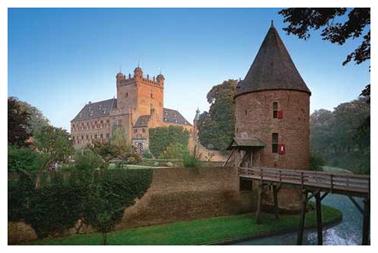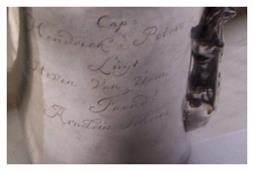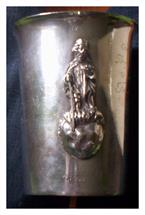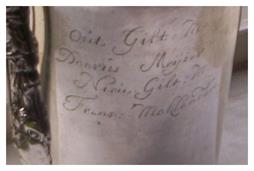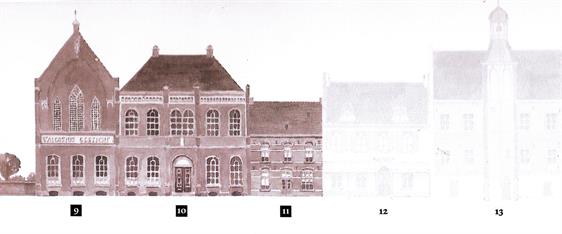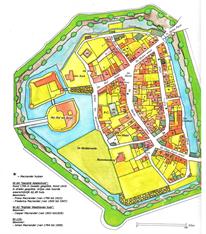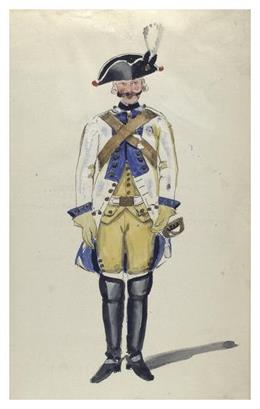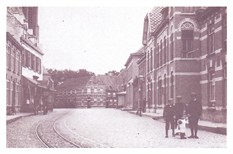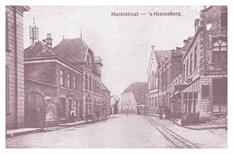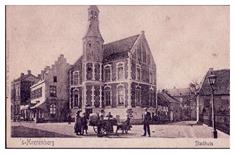

.

The following Macranders tried their luck in the Netherlands:
1. Theophilus Macrander (*1693-†1731) from Wetzlar, soldier (rank unknown) of the Dutch United East India Company (“V.O.C.”). He died in
Batavia, Dutch East Indies, at the age of 37.
2. Johann Gottfried (Fredrik) Macrander (*1697-†abt.1748) from Wetzlar, Corporal in the cavalry-regiment "Hessen-Philippsthal". A Prussian
regiment led by Wilhelm Ludwig, Count of Hessen-Philippsthal-Barchfeld (and later by Frederik Willem, Count of Rechteren) that served the
Dutch States Army. A Corporal in the Prussian army was usually a leader of about 30 soldiers.
3. Johann Henrich Macrander (*1705-†1776) from Düsseldorf. He was a jeweler in Amsterdam.
4. Johannes Jeremias Macrander (*1719) from Wetzlar, Lieutenant 1st class in the Waldeck regiment in Bergen op Zoom, in service of the
Dutch States Army.
5. Johann Hermann Macrander (*1728) from Wetzlar, Corporal in the Waldeck regiment, in service of the Dutch States Army. He was
encamped in the city Sas van Gent. Sas van Gent was a very important, fortificated city, one of strongest in Europe.
6. Jeremias (or Jeremiah) Macrander (*ca.1740-†1781), possibly a son or nephew of Corporal Johann Hermann Macrander, was Ship’s boy
(1769-1773), Ordinary seaman (1773-1776) and Able seaman (1776-1781) in service of the V.O.C.
7. Johann Hendrich (Johan Hendrik/Jan Hendrik) Macrander (*1765) from Bergen op Zoom, Ship’s boy (1779-1780), Ship Gunner (1785-1788)
and Quartermaster (1788-1790) of the V.O.C.
1. Theophilus Macrander (*1693-†1731) from Wetzlar, soldier (rank unknown) of the Dutch United East India Company (“V.O.C.”). He died in
Batavia, Dutch East Indies, at the age of 37.
2. Johann Gottfried (Fredrik) Macrander (*1697-†abt.1748) from Wetzlar, Corporal in the cavalry-regiment "Hessen-Philippsthal". A Prussian
regiment led by Wilhelm Ludwig, Count of Hessen-Philippsthal-Barchfeld (and later by Frederik Willem, Count of Rechteren) that served the
Dutch States Army. A Corporal in the Prussian army was usually a leader of about 30 soldiers.
3. Johann Henrich Macrander (*1705-†1776) from Düsseldorf. He was a jeweler in Amsterdam.
4. Johannes Jeremias Macrander (*1719) from Wetzlar, Lieutenant 1st class in the Waldeck regiment in Bergen op Zoom, in service of the
Dutch States Army.
5. Johann Hermann Macrander (*1728) from Wetzlar, Corporal in the Waldeck regiment, in service of the Dutch States Army. He was
encamped in the city Sas van Gent. Sas van Gent was a very important, fortificated city, one of strongest in Europe.
6. Jeremias (or Jeremiah) Macrander (*ca.1740-†1781), possibly a son or nephew of Corporal Johann Hermann Macrander, was Ship’s boy
(1769-1773), Ordinary seaman (1773-1776) and Able seaman (1776-1781) in service of the V.O.C.
7. Johann Hendrich (Johan Hendrik/Jan Hendrik) Macrander (*1765) from Bergen op Zoom, Ship’s boy (1779-1780), Ship Gunner (1785-1788)
and Quartermaster (1788-1790) of the V.O.C.
(Houses in the Marktstraat in 's-Heerenberg, Johannes Macrander lived in house no.11)
(The Marktstraat in 's-Heerenberg. In front
on leftside the house of Johannes Macrander)
on leftside the house of Johannes Macrander)
(Same street, seen from the opposite side. Behind hotel Verwaayen is the house of Johannes Macrander situated)
(The old city hall and next to it hotel Verwaayen (with stepped gable) and behind that, the lower part of the house of Johannes Macrander. Apparently the upper part of the house was demolished)
(House Bergh)
(Guild Cup of 1772 with the name of Frans Macrander)
The 17th century in Holland, is known as the "Golden Age". It was a period in the Dutch history, especially of the northern seven United Provinces, in which Dutch trade, science, art and military power (especially at sea) had a top position in the world. A period of unprecedented wealth and prosperity. Moreover, the Netherlands were at that time a very tolerant country because of international trade and the Reformation, which has contributed to a generally mild approach to dissenters. There was relatively much freedom in the Netherlands. Because of this fact many foreigners went to seek their fortune in the Netherlands, including many people from Prussia (Germany). Among them, some Macranders. The Macranders that went to the Netherlands at the beginning of the 18th century, did so in most cases as military in a Prussian regiment that was in service of the Dutch “Staatsche Leger” (States Army) and even in the “V.O.C.” (the Dutch East India Company).
Johannes (Hannes) was a blacksmith/horsesmith, Franciscus (Frans) a farmer and Johan Caspar (Caspar) a wagoner (= driver). Just like their stepfather, both Hannes and Frans were guild brother of the St. Antonius Guild. This was a kind of city guard/militia. The St. Antonius Guild still exists! There is even a website, that you can find here. The name of Frans is engraved on an old Guild Cup of 1772, just like the name of his stepfather. This apparently means that he and his stepfather were captains/members of the committee, probably in St. Jan's company, a division of the guild. This Guild Cup was even been on loan to the “Rijksmuseum” in Amsterdam.
Johannes (Hannes) Macrander married twice. The 1st time he married Johanna Maria Hartjes from whom he had 2 daughters: Maria Antonia and Elisabeth Frederica. In 1793 widower Hannes remarried Aleida Gudden, because “… zyn geleegenheyd niet lange is om in den weduwenaerstaet te blyven …” (old Dutch, meaning: “…it was not his fate to remain alone …”). Hannes lived 2 houses next to the town hall in the Marktstraat in 's-Heerenberg. Below you can find a picture of his house (no.11). This house is already mentioned in 1620, and was unfortunately demolished because of an expansion of the City Hall. His 2nd wife gave him 6 children: Johanna, Lambertina Catharina, Fredericus Lambertus, Stephanus (Steven) (*1803) and Anna.
Frans Macrander married Aleida Römers in 1769 and bought a house in 1802 in the Kellenstraat (no. 64 on the old citymap) in ’s-Heerenberg from Matthijs Scheers and his wife Hendrina Ketelaar. The house was traditionally called the "Hendrik Abelen huis" and was also known as "Den Engel". Frans had a 2nd home that was rented.
His brother Caspar married Anna Sloot in 1781 and lived in the “Righter Westhaven huis" in the Kellenstraat (no.82 on the old citymap). The marriage remained childless. As a middle aged man, Caspar apparently had inherited the combativeness of his soldier-father. In the summer of 1785 a Hartjen Messink paid a visit to discuss a dispute with Caspar. They were soon fighting. Caspar was receiving a helping hand by his mother, Anna-Aleida Scheers, who took a knife and left behind some scars on the face and in particular the nose of Messink. When the victim was laying on the ground, Caspar pulled him by his hair on the ground, kicked him in the face and his mother worked him extensively with the knife. She drew some deep scars on the back of Messink, right through his shirt. The victim asked the city court to sentence Caspar and his mother to provide compensation, not only for the injuries, but also for long-term unemployment. The reason for the brawl, and how the case ended is unknown. In any case, obviously it must have been a sensitive issue and it is clear that, comparing with modern time, in those times discussions were dealt a more harsh manner.
Frans Macrander married Aleida Römers in 1769 and bought a house in 1802 in the Kellenstraat (no. 64 on the old citymap) in ’s-Heerenberg from Matthijs Scheers and his wife Hendrina Ketelaar. The house was traditionally called the "Hendrik Abelen huis" and was also known as "Den Engel". Frans had a 2nd home that was rented.
His brother Caspar married Anna Sloot in 1781 and lived in the “Righter Westhaven huis" in the Kellenstraat (no.82 on the old citymap). The marriage remained childless. As a middle aged man, Caspar apparently had inherited the combativeness of his soldier-father. In the summer of 1785 a Hartjen Messink paid a visit to discuss a dispute with Caspar. They were soon fighting. Caspar was receiving a helping hand by his mother, Anna-Aleida Scheers, who took a knife and left behind some scars on the face and in particular the nose of Messink. When the victim was laying on the ground, Caspar pulled him by his hair on the ground, kicked him in the face and his mother worked him extensively with the knife. She drew some deep scars on the back of Messink, right through his shirt. The victim asked the city court to sentence Caspar and his mother to provide compensation, not only for the injuries, but also for long-term unemployment. The reason for the brawl, and how the case ended is unknown. In any case, obviously it must have been a sensitive issue and it is clear that, comparing with modern time, in those times discussions were dealt a more harsh manner.
Frans had only daughters, thus his Macrander line already ended after his death in 1816. The marriage of Caspar remained childless. According to the current available data, all Dutch Macranders are descendants of Stephanus (Steven) Macrander, son of Johannes (Hannes). Steven had only 4 children: Adelheid, Aleida, Fredricus Hubertus and Stephanus as last in 1852. Fredricus lived only 4 days. Again, the chances of continuity for the Macrander branch in the Netherlands was very small. But Stephanus married Johanna Cornelia Bernardina Hesselmann in 1885 and produced 11 children, of which no less than 7(!) sons, and thus heirs of the name.
Conclusion
The Dutch forefather is Johann Gottfried (Fredrik) Macrander (*1697-†abt.1748) who came to the Netherlands from Wetzlar (Germany) around 1720/1725. Very remarkable is that all Dutch Macranders since then (300 years ago!) are still very close related. The generation born between roughly 1920 and 1940 are first cousins. Their children, born between roughly 1950 and 1975, are first cousins, once removed. All are descendants of Stephanus Macrander (*1852-†1934). Between Fredrik (*1697) and Stephanus Macrander (*1852) there was always only 1 heir of the name who produced male offspring.
Conclusion
The Dutch forefather is Johann Gottfried (Fredrik) Macrander (*1697-†abt.1748) who came to the Netherlands from Wetzlar (Germany) around 1720/1725. Very remarkable is that all Dutch Macranders since then (300 years ago!) are still very close related. The generation born between roughly 1920 and 1940 are first cousins. Their children, born between roughly 1950 and 1975, are first cousins, once removed. All are descendants of Stephanus Macrander (*1852-†1934). Between Fredrik (*1697) and Stephanus Macrander (*1852) there was always only 1 heir of the name who produced male offspring.

(* Since Steven Macrander (*1803-†1887) the name Stephanus, Stephan, Stephanie, Steven and Stef occurs frequently
within the Dutch family. This must be a referring to Steven van Uem, the stepgrandfather of Steven Macrander and stepfather of
Johannes Macrander.)
within the Dutch family. This must be a referring to Steven van Uem, the stepgrandfather of Steven Macrander and stepfather of
Johannes Macrander.)
(Guild Cup of 1772, leftside with the name
'Steven van Uem')
'Steven van Uem')
(Guild Cup of 1772, rightside with the name
'Frans Maklander')
'Frans Maklander')

Only Theophilus and his cousin Johann Gottfried (Fredrik) produced children, the rest remained childless. The family of Theophilus has never been definitively established in the Netherlands, but remained living in Wetzlar, unlike Johann Gottfried (Fredrik). He is also the person who can be called the Dutch ancestor of all Macrander members from the Netherlands.
Johann Gottfried (Fredrik) married the Dutch Anna-Aleida Scheers from Bergh (currently named 's-Heerenberg), a small border town on the Dutch-German border. He had 5 children: Franciscus Johannes (*1740), Johan Caspar (*1742), Juliana Margaretha (*1744), Catharina Margaretha and Johannes (abt. 1748). Fredrik died about 1748, possibly as a result of war actions during the War of the Austrian Succession (1740-1748). He left behind his widow with 5 young children, whose two eldest were not 10 years old yet. Shortly after, on 16-11-1749, Anna-Aleida Scheers remarried to Steven van Uem. The youngest Macrander-children will have hardly remembered their father Fredrik. The Macrander-children grew up in beautiful surroundings, dominated by the families of the house Bergh, van Nispen tot Pannerden, Van Nispen tot Sevenaer and other significant dynasties in their manorial estates.
Johann Gottfried (Fredrik) married the Dutch Anna-Aleida Scheers from Bergh (currently named 's-Heerenberg), a small border town on the Dutch-German border. He had 5 children: Franciscus Johannes (*1740), Johan Caspar (*1742), Juliana Margaretha (*1744), Catharina Margaretha and Johannes (abt. 1748). Fredrik died about 1748, possibly as a result of war actions during the War of the Austrian Succession (1740-1748). He left behind his widow with 5 young children, whose two eldest were not 10 years old yet. Shortly after, on 16-11-1749, Anna-Aleida Scheers remarried to Steven van Uem. The youngest Macrander-children will have hardly remembered their father Fredrik. The Macrander-children grew up in beautiful surroundings, dominated by the families of the house Bergh, van Nispen tot Pannerden, Van Nispen tot Sevenaer and other significant dynasties in their manorial estates.

(Map of the medieval city of Bergh with house no.64 of Frans and Frederica, house no.82 of Caspar and house no.120 of Johannes Macrander)
(The uniform of Johann Gottfried 'Fredrik' Macrander, as Corporal of the cavalry-regiment "Hessen Philippsthal" .)
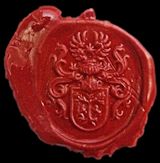



Find more photos in the photoalbum under button 'images'.
.



- Home
- History
- Origin of the name Macrander
- Origin of the name Langemann
- 1500s: Councilman Arnold Langemann
- 1500s: Magister Josias Macrander
- 1600s: Organ builder Joh. Friedr. Macrander
- 1700s: The first Macranders in the Netherlands
- 1800s: The first Macranders in the USA
- 1900s: The first Macranders in Brazil
- Occupations & Functions 1500s till 1700s
- Family tree
- Coats of Arms
- Images
- Overview
- Documents
- Photos Brazil
- Photos Germany
- Photos Netherlands
- Stephanus Macrander (*1852-†1932)
- > Frans Macrander (*1887-†1962)
- > Bertus Macander (*1889†1967)
- > Gerrit Macrander (*1891-†1986)
- > Louis Macrander (*1893†1964)
- > Theo Macrander (*1895†1962)
- > Wim Macrander (*1897†1974)
- > Anna Macrander (*1899†1994)
- > Dicky Macrander (*1901-†)
- > Stefaan Macrander (*1904-†1974)
- Family announcements etc.
- Photos USA
- John Albert Macrander (*1843-†1921)
- > Charles Oscar Macrander (*1893-†1970)
- >> Gordon Chester Macrander (*1915-†1983)
- John Macrander (*1819-†1910)
- > William Thomas Macrander (*1860-†1923)
- >> Eva Lena Macrander (*1882-†1914)
- >> Maude Olive Macrander (*1885-†)
- >> Bertha Ellen Macrander (*188X-†)
- >> Charles Orville Macrander (*1894-†1978)
- > John David Macrander (*1863-†1951)
- >> Wayne Orle Macrander (*1895-†1954)
- >> Josiah Don Macrander (*1897-†)
- >> Theodore Zed. Macrander (*1902-†1989)
- >> Lawrence Carol Macrander (*1905-†1994)
- > George Oliver Macrander (*1865-†1931)
- >> Zerah Todd Macrander (*1897-†1959)
- Contact
- Guestbook
- News/Links


